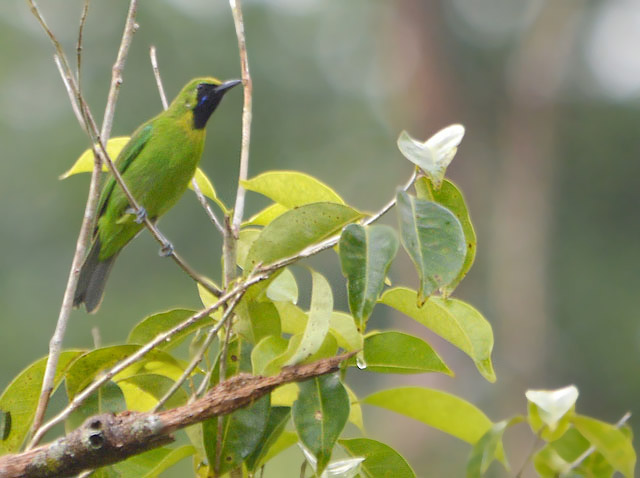The
trip did not start out all that smoothly. There were delays here and there during
the journey to Bukit Panchor State Park. When we arrived at the destination, we
were disappointed to find the boardwalk flooded from last night’s downpour. However,
sometimes things do happen for a reason. As we lingered around the entrance to
the boardwalk contemplating our ill luck, the surrounding forest started to
come alive. First was the array of calls. Followed by movements among the
vegetation. Then a Stripe-throated Bulbul decided to start the morning by
calling from an exposed perch and I should have known then that was a sign that
today was going to be special despite the locality’s unimpressive record of
late.
No,
it took a handsome Tiger Shrike in breeding plumage to make me realize that. After
a prolonged observation of this Tiger Shrike on the prowl for breakfast, it was
a unanimous decision to stay put and wait for whatever else that may pass
through here.
A
Yellow-vented Bulbul may not be a species that local birders desire due to its
abundant nature but you cannot really hold that against it.
It
is good to see that the Jungle Myna is still predominant here – for now.
More
often heard than seen, the Gold-whiskered Barbet should be the commonest Barbet
species here. I was lucky enough to catch this individual as it took a breather
among the foliage of the forest canopy. It is an impressive bird and every
sighting will not go unappreciated.
Both
the Yellow-bellied Prinia and Rufescent Prinia occur here in Bukit Panchor.
Their ranges may even overlap but the Yellow-bellied Prinia will not venture
into the forest proper and this foraging individual provided a brief moment to
capture its image when it alighted on a bare perch.
My
attention was immediately diverted when a Buff-necked Woodpecker started to
call in the vicinity. This species is not common here in Penang State and when
the woodpecker finally revealed itself, there was no shame in not being able to
contain my excitement.
We
were given ample time to enjoy the encounter and wonderful views. The missing
red malar stripe meant that it was a female and her performance today was most
commendable.
Several
other species came and went but one of the most notable was a Little
Green-Pigeon in flight. A pair of Lesser Green Leafbirds was attracted to a
nearby fruiting tree. Judging from the images I obtained, the tree was just not
near enough for my modest equipment.
The Blue-throated Bee-eaters filled the vicinity with their calls but kept a distance for most of the time. One did alight slightly closer but the lighting condition was most challenging.
There
was just something about the trees surrounding us that were drawing in
woodpeckers. The Rufous Woodpecker was the second species to be recorded but it
was a distant encounter. As the name implies, the Common Flameback is one of
the commoner species of woodpeckers in the country. The plumage especially the
male with flaming red crest, is amazing and a close encounter like this one can
still, very much, rock my world.
When
things started to sizzle down, we decided to venture into the forest which was
our initial plan. The mass of Bertam Palms is a distinct feature of this park
but there are hardly any bird activities among these prickly vegetation at this
site.
Birding
in this dense and gloomy forest was frustrating as usual. I rarely had any
opportunity to raise my camera despite the occasional birdwave or two. This
Dark-sided Flycatcher ought to be back in the mountainous regions of northern
Asia by now but here it is, testing the patience of a few birders by remaining
in the darkest spot of the forest.
From
the look of things, the group of Fruit Bats residing at the hut along the
access trail just got a little bigger. The paler individuals I assume are young
ones and the parents were a little anxious of my presence – a situation that I
quickly remedied.
One
of the highlights of the day was this 3-inch caterpillar. If memory serves me
right, this is the biggest caterpillar I have ever laid eyes on and it was
quite a sight. I will not hazard a guess of its true identity. Insects are
mostly beyond me and this little mammoth certainly was.
When
things do fall in place when birding in the forest, something remarkable will usually
unfold. A family of Checker-throated Woodpeckers kept us company for quite a
long time from the cover of the forest canopy and initially, I did not think
anything significant would materialized from this. Then, one decided to descend
from its lofty domain and alighted almost at eye level. This is one of the
reasons why we birders endure all those hours wandering aimlessly in the heat
and humidity of the tropical rainforest time after time – a chance to
experience the alluring bird life found here up close and personal.
The incomplete chestnut colouration on the plumage suggested that it is a young bird but it did not make much difference. I was mesmerized by the presence of this woodpecker for it is a striking bird. The birding excursion here this time was surprisingly fruitful and it just goes to show one cannot truly know what to expect when it comes to birding. And this confiding young Checker-throated Woodpecker certainly played a big role in the outcome of the trip.





















No comments:
Post a Comment